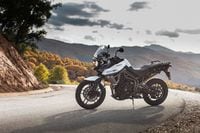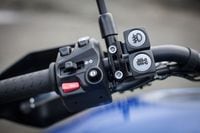Some of the more savvy, cutting-edge motorcycle companies have realized the parallel ideas of on- and off-road adventure touring and have multiple models. KTM has two versions of the 1190 Adventure and BMW has two versions of both the F800 and R1200 GS models. Triumph has already used this tactic—the Tiger 800 has been offered in cast-wheel "standard" version and a spoke-hooped model called the XC. But Triumph is now taking the "genetic" engineering of motorcycles to the next level, with the new Tiger 800 coming in four trim levels. For 2015 there will be the cast-wheel XR and the off-road-intentioned, spoke-wheel XC, but both Tigers will come in available "x" packages (that's XRx and XCx) with even more options.
Before we get into the hair-splitting, let’s talk about the stuff that hasn’t changed. Triumph has offered the 800cc Tiger since 2010, when the UK firm stroked its successful 675cc Street Triple engine and mounted it in a tall, tubular-steel chassis. The Tiger was available in standard form, or outfitted with crash-guards and other adventure-y bits in “XC” trim. The chassis, powerplant, and attitude of the Tiger remain, but Triumph has overhauled the finer points of its middleweight ADV.
The second version of the 800cc inline triple debuts in the new Tiger, the most significant update being the addition of ride-by-wire technology, allowing the factory to tune the engine more accurately and add features, like standard cruise control. A gaggle of other little changes have taken place, too. Triumph claim that new air intakes, fuel injectors, and cam profiles amount to a 17-percent more efficient burn in the combustion chamber, making the 800 the cleanest triple in the Hinckley line.
Gearbox pieces from the 675 Daytona sportbike have trickled down (up?) to the Tiger, which Triumph says makes for smoother and easier shifting. A higher output alternator might sound boring, but powering the electronics that ADV riders love (think GPS, heated gear, and the like) is anything but—there’s even a system that saves the battery if electrical draw exceeds the charging system. Clever stuff.
How it all works, of course, is key, and it’s interesting that Triumph went through so much trouble to update the Tiger 800. The two aforementioned model options (standard and XC) saw roughly equal sales, and proved a very successful piece of Triumph’s family. Rather than seeing the balanced sales figures as a nail hit squarely on the head, Triumph chose to slice the Tiger 800 even thinner.
Our two-day test ride started on the XCx with a short loop of gravel roads and light off-road, surely to encourage us to experiment with the Tiger 800’s new ride modes (standard on the up-spec “x” models). Selecting Off-Road via a dashboard-mounted button softens throttle response and sets traction control and ABS to pre-set off-road maps. This allows the rear wheel to spin a little on acceleration, and full locking of the rear wheel on the brakes. Front-wheel ABS works wonderfully, saving traction smoothly but giving control back to the rider quickly, although Triumph engineers claimed it’s only designed to engage during panic braking.
Traction control impressed us less. The system allegedly lets the rear wheel spin faster than the front wheel is turning, but often seems indecisive. It functions to save meat-fisted throttle inputs, but doesn’t stack up to comparable systems from BMW and KTM.
Lucky for us, and for Triumph owners, the 800cc triple is so incredibly smooth that off-road traction control simply isn’t necessary. Provided traction is predictable, the Tiger’s engine puts out perfectly calibrated power at every rpm, peaking at a claimed 94 hp. (Peak power, incidentally, is the same as the previous bike, to stay under regulations for European license tiers).
A dirt-proper 21-inch front wheel eats bumps happily. It’s paired with a 17-inch rear rim running a 150/70 radial tire, which is pretty much the industry-standard size for the class. The popularity of ADVs has created demand for a wide range of highway-legal, dirt-worthy tires. Gone are the days you needed an 18-inch rear to run the most capable ADV tires.
The best part of the new XC is definitely the addition of WP suspension, which feels much higher quality than the previous model’s (and the current XR’s) Showa pieces. The XC’s fork and shock also have more travel than the XR (40mm more in the fork, and 45mm in the shock), which is always a benefit in an ADV bike, provided your inseam allows. The XC seat is adjustable, but only from 33.8 down to 33 inches (the XR's seat adjusts down to as low as 31.8 inches.)
Riding for the rest of the day along choppy streets of mountain towns and through sweeping curves, the WP suspenders proved worthy of sport-touring too. (Nobody was surprised. WP’s excellent calibration has impressed us for years when mounted to KTM’s finest.) Similarly, the XCx’s 21-inch front wheel was advantageous off-road but felt just fine when applied to pavement. When the tall, lanky XCx was warming up for the ride it never seemed possible that the footpeg feelers would drag, but they eventually did, simply because the XCx will carve corners with the best of them.
On day two of riding we explored many of the same roads (save the dirt) on the lower-spec XRx variant of the Tiger. With cast wheels, the 17-inch rear is paired with a 19-inch front rim, and shod with Pirelli Scorpion rubber (same as Ducati’s Multistrada, incidentally). The Off-Road ride mode will likely see less use on the XRx; we found ourselves in Road, or the mode labeled “Rider,” which allows the rider to choose from each of the available ABS and TC modes (road, off-road, and off) as well as four throttle maps (sport, road, off-road, and rain) to tailor the electronics to suit one’s mood.
While the XR’s shorter-travel Showa suspension feels slightly less refined compared to the XC’s WP bits, it still makes for an excellent ride. That there’s plenty of feedback from the fork and front wheel made for confidence inspiring carving of canyons and lots of smiles in the helmet.
The XR is the cheaper of the two models, but the upgraded XRx comes with some do-dads that the XCx doesn’t get. A slightly adjustable windscreen, and the “comfort” seat, specifically. Both are accessories, and available to any Tiger owner, but XRx buyers will still have reason to beam.
The Tiger 800 still carries itself like an ADV, with a broad-shouldered and purposeful look, and it still delivers a comfortable, pleasing ride no matter what surface your choose. Pricing is pretty easy to swallow, too; a base model XR starts at just $11,399 (likely not far from Yamaha’s highly anticipated FJ-09), though it basically only includes ABS and traction control, but none of the other options. Add $1,100 for the upgraded XRx, which includes the ride modes, ABS and TC modes, the throttle map options, cruise control, center stand, hand guards, and a more expansive trip computer.
The XC starts at $12,399, and is similarly thin on options (although it does still come fitted with the fully adjustable WP suspension). Upgrade to the XCx for the same $1,100 ($13,499) and you’ll get mostly the same bells and whistles as the XRx, minus the comfort seat and adjustable windscreen, but plus crash guards and an aluminum skid plate.
At the end of the test the most striking impression in riding the XRx was that it feels very much like a road bike, rather than an ADV. This is very much what we imagine the Yamaha FJ-09 will feel like. Conversely, the XCx has more options and looks ready to take on BMW's F800GS Adventure again, where it lost in a knockout last time (aluminum bags are an option). (Click here to read our last test of the Tiger 800 vs BMW's F800GS Adventure.)
In broadening the capability of its mid-sized adventure tourer, we think Triumph has softened the Tiger 800’s sex appeal a little, but the truth is the bike (in any form) is more adept than ever.




























/cloudfront-us-east-1.images.arcpublishing.com/octane/2WF3SCE3NFBQXLDNJM7KMXA45E.jpg)
/cloudfront-us-east-1.images.arcpublishing.com/octane/G4MG6OUCJNBSHIS2MVVOTPX65E.jpg)
/cloudfront-us-east-1.images.arcpublishing.com/octane/IIGGWFOTOJGB7DB6DGBXCCMTDY.jpg)
/cloudfront-us-east-1.images.arcpublishing.com/octane/QSTCM6AVEZA5JJBUXNIQ3DSOF4.jpg)
/cloudfront-us-east-1.images.arcpublishing.com/octane/U4I7G625B5DMLF2DVIJDFZVV6M.jpg)
/cloudfront-us-east-1.images.arcpublishing.com/octane/B6XD6LS6IVCQPIU6HXDJSM3FHY.jpg)
/cloudfront-us-east-1.images.arcpublishing.com/octane/ICL63FEDDRDTTMINYICCEYGMDA.jpg)
/cloudfront-us-east-1.images.arcpublishing.com/octane/FCGZHQXRBZFLBAPC5SDIQLVF4I.jpg)
/cloudfront-us-east-1.images.arcpublishing.com/octane/WNOB6LDOIFFHJKPSVIWDYUGOPM.jpg)

/cloudfront-us-east-1.images.arcpublishing.com/octane/X33NU3E525ECRHXLNUJN2FTRKI.jpg)
/cloudfront-us-east-1.images.arcpublishing.com/octane/6KKT5NNL2JAVBOXMZYS5ZO76YA.jpg)
/cloudfront-us-east-1.images.arcpublishing.com/octane/J5RKG5O455GMPGQRF2OG6LRT7A.jpg)
/cloudfront-us-east-1.images.arcpublishing.com/octane/GX2CIZKQVRH2TATDM26KFG2DAE.jpg)
/cloudfront-us-east-1.images.arcpublishing.com/octane/ZWIDYSAKQZHD5BHREMQILXJCGM.jpg)
/cloudfront-us-east-1.images.arcpublishing.com/octane/CYUHJZCTSJCH3MRAQEIKXK7SCQ.jpg)
/cloudfront-us-east-1.images.arcpublishing.com/octane/LKOFINY56FCXJCANJ5M7ZDQUBY.jpg)
/cloudfront-us-east-1.images.arcpublishing.com/octane/4NBPDACMWJH63JQYJVK3QRBDZI.jpg)
/cloudfront-us-east-1.images.arcpublishing.com/octane/KKHQHRR3FJGX7H2IPU6RALMWG4.jpg)

/cloudfront-us-east-1.images.arcpublishing.com/octane/5IOFS5JAE5FOXMNA23ZRAVVYUU.jpg)
/cloudfront-us-east-1.images.arcpublishing.com/octane/CGXQ3O2VVJF7PGTYR3QICTLDLM.jpg)

/cloudfront-us-east-1.images.arcpublishing.com/octane/OQVCJOABCFC5NBEF2KIGRCV3XA.jpg)